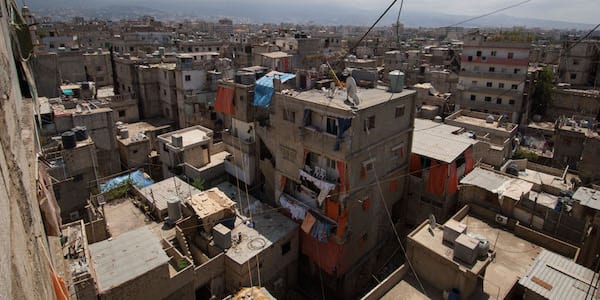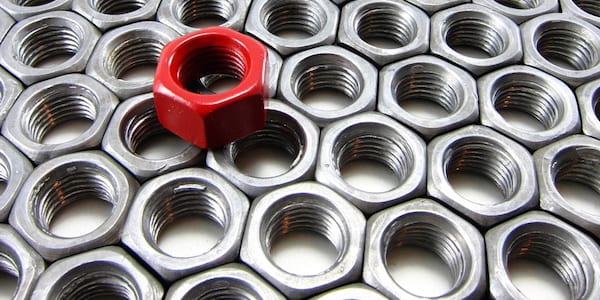
The lean approach helps manage UN refugee project in Lebanon
FEATURE – In the Shatila camp south of Beirut, a self-help program is making a difference in the lives of Palestinian refugees, engaging them in rehabilitating their shelters.
Words: Farook Hamzeh, assistant professor in Civil and Environmental Engineering, American University of Beirut; Mahmoud El Jazzar, Masters candidate, American University of Beirut
Photo (above) courtesy of Phil Coomes
Following the 1948 war in the Middle East, 12 camps were established in Lebanon to accommodate the Palestinian refugees who fled the conflict or were expelled.
Even though they were not designed for long-term habitation, the camps quickly had their tents turn into concrete block structures with zinc roofs, which in turn became concrete-roof shelters. Today, around 455,000 refugees are registered with the United Nations Relief Works Agency (UNRWA) in Lebanon.

Shatila camp, in southern Beirut, was set up by the International Committee of the Red Cross in 1949 to take in refugees from northern Palestine. Today, it is home to up to 22,000 refugees (exact estimates are difficult due to a recent massive influx of Syrian refugees) living in overcrowded high-rises that stand side-by-side all around the camp, overlooking an intricate maze of buzzing alleyways. Life is extremely hard in Shatila: health conditions are very bad, and many shelters are crumbly and in disrepair.
Most of them were built without a previous engineering study and their concrete elements were poured using seawater and sea sand, which are known to create weak and fast-degrading structures. Adding to the poor construction methods implemented, several shelters were destroyed by shelling and bombing during the regional and civil wars that rocked Lebanon in the '70s and '80s.
The United Nations Relief Works Agency (UNRWA) provides services to the camps, such as education, development, healthcare, and sanitation. It started its operations in 1950, and has assisted more than 4.7 million refugees in Gaza, West Bank, Lebanon, Jordan, and Syria since then.
The refugee camps with UNRWA operations exist on land that is leased from either the government or private owners. Their borders haven't changed in 60 years, and horizontal and vertical expansion is strictly forbidden. In addition, construction materials are not allowed inside the camps – which makes the rehabilitation of shelters even more difficult.
UP FOR THE CHALLENGE
Sawsan Youssef is a 60-year-old resident of Shatila. A widow, she lives by herself in an 18-square-meter rickety shelter that comprises of a kitchenette, toilet, and small bedroom. The world seems to have given Sawsan little to hope for: she was born in the captivity of the camp (Palestinian refugees are stateless and cannot apply for citizenship), she has never seen her native country and she lives in miserable conditions. Her dream is not to have the latest smartphone or HD flat screen television, but to have a decent, hygienic living place - and maybe "a window with sunlight shining through."

According to a UNRWA survey, there are over 4,000 shelters in need for rehabilitation in Lebanon's refugee camps. Sawsan's was selected for the UNRWA's "self-help" rehabilitation project, which is funded by the European Union.
The UNRWA has implemented rehabilitation projects for years, but traditionally they were performed by contractors. In 2011, however, two families took the initiative during one of the ongoing projects and asked the Agency permission to take the place of contractors and carry out the work by themselves.
That was the start of the self-help approach where the families build or rehabilitate their shelters by managing the work themselves (or hire local craftsmen if they don't have the necessary skills) under the supervision and approval of the UNRWA engineers. This new method offered hope and great opportunity to camp dwellers.
For Sawsan, it meant having a rehabilitated shelter in 12 weeks.
Enthused by the prospect, she was determined to succeed and remained heavily involved throughout the rehabilitation process. She rarely left the site. In many occasions, she solved problems related to material delivery, storage, and even neighbors concerned about shelter boundaries. She traveled and visited the suppliers, made deals in advance in order to deliver the required materials to the site without delay, hence removing all potential constraints beforehand. Even though she hired a contractor to execute the concrete works, she was always present to oversee the process. After all, this project was her opportunity to shape her residence (and her future) and to have a say in every design and construction detail.
Sawsan managed to complete her shelter one week ahead of schedule with no additional costs, as the images below show. The success of this initiative (proven in this and many other examples) has led the UNRWA to use self-help in a number of projects. The approach is giving refugees in Lebanon new hope.
"SELF-HELP" AS A LEAN PROCESS
When applied to construction, lean thinking strives to deliver projects that maximize value for stakeholders while reducing waste during the project design, procurement, and construction phases.
This application of the methodology is gaining momentum around the world, as urban planners, politicians and city managers recognize the need to inject efficiency and speed into the maintenance and renewal of our infrastructure as well as to build more to accommodate an increasing number of urban dwellers (by 2050 66% of the world population will live in urban areas). Private construction businesses are also recognizing the superiority of lean as an approach that can not only keep them in the game, but also help them to grow.
While not a "lean project" per se, the self-help approach deployed in the Shatila camp responds to a similar need: fixing as many shelters as possible, for as many refugees as possible, as quickly and cheaply as possible.
One of its most remarkable outcomes is a lower price per shelter unit, which of course translates into an increase in the total number of shelters that can be rehabilitated with the same amount of donations.
Additionally, self-help greatly improves the flow in the customer's (refugee) value stream, from the time the award is received from the UNRWA to the time the shelter is ready for occupation. Since the families are directly engaged in decision making, they play a huge role is shaping value in every step of the rehabilitation process: choosing the façade and interior colors, deciding on the layout of windows and interior partitions, hiring contractors and workers, engaging directly with material suppliers, and sometimes even participating in construction tasks.
Throughout the delivery process, families strived to get quality right first time and to improve quality at source (another lean principle), because rework is not paid for by the UNRWA and families cannot afford it. This also encouraged social interaction between beneficiaries to share successful ideas, best practice, information on successful contractors and skilled workers. Moreover, since the families are not given any rent subsidies during the rehabilitation of their shelters, they were motivated to work faster to avoid paying additional rental costs.
Another aspect that helped improve the flow of work is the interim payments (assigned to a specific set of completed tasks) that the families used to receive upon satisfactory completion of the work. This ensures the money is spent on construction works and nothing else.
The self-help method also supports the lean principle of genchi gembutsu, encouraging people to "go see" if they want to fully understand the situation. In this case, the families are always at the gemba to supervise work directly, approve and improve any construction detail, expedite the flow of materials, call workers on site at the right time (sounds like pull), and remove constraints to the smooth completion of tasks. Essentially, self-help develops a network of partners, as envisioned by lean thinking.
One of the key points of lean is the reduction of in-process variability. In Shatila, as they rehabilitated their shelters, families always hired multi-skilled workers to decrease the uncertainty associated with assigning different tasks to different teams. Moreover, the use of pull systems to avoid overproduction was central to shelter work since families pulled workers, material, and tools at the right time to avoid any waiting (as shown in the figure below).
Dealing with variability and lack of urban design in the camps was one of the biggest hurdles for these projects; therefore, UNRWA had to create a set of standards on, for example, materials, project schedule, budget, and the number of rooms each shelter could have.

Despite having enjoyed a certain degree of success, self-help has a few limitations. To begin with, it puts the burden of realizing the delivery of a project and managing the execution process onto the families. While this adds to the overall value of the project, it comes with huge efforts on their side. Another big limitation is the payment method: because funds are paid to the beneficiaries through the bank, whenever payments were delayed the construction workflow was hugely disrupted.
In summary, self-help can turn around the lives of refugees. The beneficiaries are poor and underprivileged, and giving them a chance to play a positive role in their lives at a personal and social level pays great dividends. It encourages families to actively participate in achieving their dream of having a decent home, increases their morale, and gives them hope - for an average $10,000 per shelter.
Come to think of it, this reflects yet another lean principle, one that promotes management decisions to achieve a long-term objective, even at the expense of short-term financial goals.
Although it has not been part of the UNRWA's work for a long time, self-help has already managed to prove how beneficial a "leaner" method can be, thus leapfrogging traditional ways in which shelters are rehabilitated.
OPTIMIZING WORKFLOW IN REHABILITATION PROJECTS USING COMPUTER SIMULATION
Optimizing workflow is one of the goals of a lean implementation. To streamline the rehabilitation of 736 shelters in United Nations refugee camps in Lebanon, a section of the project involving 30 shelters was modeled using discrete event simulation.
The goal was to study the causes of disruption in workflow and recommend possible methods to improve project performance. Different scenarios were examined to optimize construction workflow, taking into account the various constraints. The ultimate goal is to increase the value delivered to the refugees, the beneficiaries of the project.
The 30 shelters the project focuses on are in the Burj El Barajne refugee camp. It models the process of new construction for 12 of them and of rehabilitation for the remaining 18. The project has two major resource constraints: one is that there is only one material supplier allowed into the camp with one supply route and one truck that can move around the camp at a certain time; the other is that only contractors present within the camp can initiate works.
Consequently, only 12 contractors are available and responsible for the 30 shelters.
A discrete event computer simulation was built using EzStrobe to model the following processes: establishing the contractual agreement, contract amendments and revisions, material procurement and supply to the camp, shelter construction process, and shelter rehabilitation process.
The objective of building this model was to optimize the system's flow by making sure that all the resources were properly used leading to optimum project cost, duration and resource utilization. Moreover, the model helped to identify waste and bottlenecks. Upon unearthing the sources of inefficiencies, several scenarios were simulated, in order to determine the optimum situation resulting in the best balance between total project cost, resource utilization, and project duration.
In the simulation, the number of material suppliers and trucks varied along with the number of contractors. The impact of varying resources on the project cost and duration were examined closely to examine the efficacy of each "combination." Identifying idle time as one source of inefficiency in the system led to developing different scenarios to optimize performance. These featured varying numbers of suppliers and contractors to minimize construction cost and duration, which led to the conclusion that the number of suppliers and trucks represents a bottleneck, and that adding contractors will only make the system more wasteful.
The simulation results highlighted interesting outcomes. Significant reductions in cost, contractor idle time, and total project duration can be attained when optimizing the number of suppliers and trucks. It also showed the power of simulation modeling in identifying sources of waste and providing alternatives to remove them and make the system lean. One of the solutions suggested to adjust the number of suppliers was later implemented in real life, thus validating the results of this study.
THE AUTHORS


Read more


ARTICLE – Standardization is often ignored and misunderstood, but is as critical to a lean transformation as continuous improvement. This piece by our Polish team explains why standard work is not to be neglected.



CASE STUDY - HM Courts & Tribunals Service has been using lean ways of working for over six years, learning many lessons along the way and achieving some fantastic wins.


FEATURE – Learn how Lean Thinking and the establishment of Communities of Practice are transforming automotive reconditioning at Aramis Group.


FEATURE – The author discusses the impact of the Covid-19 pandemic on the companies and the needs of individuals in her town of Maun, Botswana, and wonders what role lean can play in their lives.

